 |
 |
 |
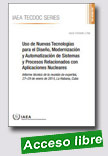 |
Uso de Nuevas Tecnologias Para el Diseño, Modernizacion Y Automatizacion de Sistemas Y Procesos Relacionados con Aplicaciones Nucleares
IAEA TECDOC, 2016, 133 p.
Durante los últimos años el Organismo Internacional de Energía Atómica ha organizado una serie de proyectos de cooperación técnica orientados a ampliar y fortalecer las capacidades de los laboratorios que trabajan con instrumentación nuclear, así como a desarrollar prototipos de instrumentos e interfaces que permitan dar respuesta a
|
diferentes necesidades de las aplicaciones nucleares en la región de América Latina y el Caribe (RLA).
La introducción de tecnologías avanzadas para el diseño de instrumentación, interfaces y dispositivos especializados, así como para realizar trabajos de automatización de sistemas o procesos relacionados con aplicaciones nucleares, ha permitido hacer un mejor uso de la instrumentación disponible.
Los trabajos de reparación y modernización constituyen una alternativa para contrarrestar la falta de servicios de mantenimiento por parte de los proveedores de equipos que exceden el tiempo de vida útil previsto por los fabricantes (obsolescencia planificada). Los diseños especializados no solo permiten resolver necesidades específicas, sino que con frecuencia contribuyen a reducir los costos y los plazos de ejecución de los trabajos.
Una reunión de expertos fue realizada en el marco del proyecto regional RLA1011 (Apoyo a la
Automatización de Sistemas y Procesos en Instalaciones Nucleares) para preparar un informe técnico que brindase recomendaciones a los estados miembros del OIEA sobre el estado actual de desarrollo de varias tecnologías avanzadas y sus principales campos de aplicación, incluyendo ejemplos de trabajos realizados en la región en el marco de este proyecto.
Extraído de: http://www-pub.iaea.org/MTCD/Publications/PDF/TE-1765_web.pdf
|
 |
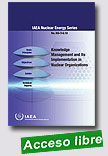 |
Knowledge Management and Its Implementation in Nuclear Organizations
IAEA Nuclear Energy Series, 2016, 52 p.
The IAEA’s nuclear knowledge management activities provide guidance in knowledge management and assist in transferring and preserving knowledge, exchanging information, establishing and supporting cooperative networks and in training the next generation of nuclear experts. This publication shares best practices and experiences based on the knowledge management assist visit programme undertaken by IAEA expert teams during the period 2005-2013. |
These visits have involved different types of organizations, including NPPs, nuclear R&D organizations and nuclear based educational establishments such as universities. Based on the records of these visits, a secondary aim of this publication is to provide feedback and recommendations for future development of the assessment tool(s) and participating organizations for improving future assist visits.
Extraído de: http://www-pub.iaea.org/books/IAEABooks/10849/Knowledge-Management-and-Its-Implementation-in-Nuclear-Organizations
|
 |
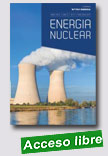 |
Cadernos FGV Energia: Energia Nuclear
FGV Energia, Abril 2016, 88 p.
A FGV Energia lança, em 27 de abril, o Caderno Energia Nuclear que busca estimular a reflexão sobre uma estrutura de planejamento energético, onde a definição do portfólio de fontes considere o potencial de desenvolvimento econômico e a geração de renda dos projetos de térmicas, sem que seja necessário abrir mão do controle de emissões e da sustentabilidade ambiental.
“A energia nuclear é uma fonte limpa, que não emite poluentes atmosféricos nem gases do efeito estufa e é a
|
quarta maior fonte geradora de eletricidade do mundo, sendo usada em mais de 30 países. Por isso, tem sido colocada pelo Painel Intergovernamental sobre Mudanças Climáticas (IPCC) e a Agência Internacional de Energia (IEA) como uma das tecnologias a serem consideras nas iniciativas para redução de emissões”, afirma a pesquisadora da FGV Energia e uma das autoras da publicação, Renata Hamilton de Ruiz.
Extraído de: http://fgvenergia.fgv.br/eventos/lancamento-do-caderno-de-energia-nuclear-fgv-energia
|
 |
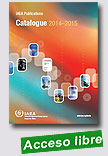 |
Radiotherapy requires competent professional staff to ensure safe and effective patient treatment and management. There is a need to provide guidelines that recommend appropriate staffing levels to support the initiation of new services as well as the expansion or upgrade of existing services as even simple upgrades or replacement of existing equipment may have a significant impact on staffing needs. Similarly, the introduction of education and training programmes will require |
staffing adjustments. A calculation algorithm was developed to predict staffing levels based on the inputs that are known or can be easily estimated. This publication complements other IAEA publications used to support the initiation of basic radiation medicine services including Setting up a Radiotherapy Programme: Clinical, Medical Physics, Radiation Protection and Safety Aspects, published in 2008.
Extraído de: http://www-pub.iaea.org/books/IAEABooks/10800/Staffing-in-Radiotherapy-An-Activity-Based-Approach |
 |
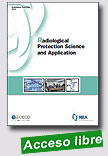 |
Radiological Protection Science and Application
Nuclear Energy Agency (NEA), 03/03/16, 111 p.
Since the discovery of radiation at the end of the 19th century, the health effects of exposure to radiation have been studied more than almost any other factor with potential effects on human health. The NEA has long been involved in discussions on the effects of radiation exposure, releasing two reports in 1994 and 2007 on radiological protection science. This report is the third in this state-of-the-art series, examining recent advances in the understanding of radiation risks and effects, |
particularly at low doses. It focuses on radiobiology and epidemiology, and also addresses the social science aspects of stakeholder involvement in radiological protection decision making. The report summarises the status of, and issues arising from, the application of the International System of Radiological Protection to different types of prevailing circumstances.
Extraído de: http://www.oecdnea.org/tools/publication?query=&div=&lang=
&period=6m&sort=title&filter=1#p7265
|
 |
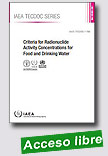
|
Criteria for Radionuclide Activity Concentrations for Food and Drinking Water
IAEA TECDOC, 2016, 63 p.
This TECDOC considers the various international standards designed for application at the national level for the assessment of levels of radionuclides in food and in drinking water in different circumstances for purposes of control.
The objectives of this TECDOC are to collate and provide an overview of: (1) the different radiation protection criteria used for assessing and controlling the radionuclide content of food |
and drinking water for radiation protection purposes; and (2) the approach used to derive reference levels for radionuclide activity concentration for food and drinking water for existing exposure situations, as criteria for use in exceptional circumstances.
This TECDOC is intended for use by regulatory bodies, policy makers and interested parties with responsibilities in relation to the management of various situations where radionuclides are or could be present in food and in drinking water.
This overview could be considered by Member States in developing national standards for radionuclide activity concentrations for food and drinking water.
Extraído de: http://www-pub.iaea.org/MTCD/Publications/PDF/TE-1788_web.pdf
|
 |
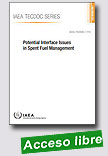 |
Potential Interface Issues in Spent Fuel Management
IAEA TECDOC, 2015, 174 p.
Opportunities to efficiently manage the back end of the fuel cycle (BEFC) are lost if interfaces are not identified and addressed in the early planning stages.
The objective of this report is to suggest and illustrate a process for systematically identifying and evaluating the potential interfaces issues in spent fuel management, and to give examples of effective management approaches based on the experience of Member States.
|
The conclusions made in this report are based on the experience and opinion of the members of the consultancy meetings and Member States that participated in the technical meetings. Many of the interfaces and recommendations reflect good practices identified in existing national and international standards and guides. Nonetheless, the rigorous process for identification of interfaces as outlined in this report helps to systematically identify issues and opportunities associated with management of the interfaces within the BEFC.
Extraído de: http://www-pub.iaea.org/books/IAEABooks/10893/Potential-Interface-Issues-in-Spent-Fuel-Management
|
 |
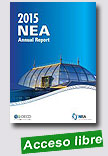 |
NEA Annual Report 2015
Nuclear Energy Agency (NEA), 21/04/16, 63 p.
At the end of 2015, there were 442 reactors in operation in 33 countries worldwide, representing over 380 GWe of capacity, with NEA member countries operating
348 of these reactors and 319 GWe, or 84% of the world total. Ten new reactors were connected to the grid in 2015, including Shin-Wolsong 2 in Korea and Beloyarsk 4 in the Russian Federation; construction began on 4 reactors, bringing the total number of reactors under construction to 67. Sendai 1
|
and 2 became the first two reactors to restart in Japan under the new regulatory regime, with Takahama 3 and 4 expected to return to operations in early 2016 after local government approvals were completed in December 2015. (...)
Extraído de: http://www.oecd-nea.org/pub/activities/ar2015/ar2015.pdf
|
 |
|
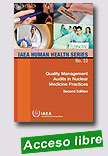
|
Quality Management Audits in Nuclear Medicine Practices, Second Edition
IAEA Human Health Series, 2015, 83 p.
Quality management systems are essential and should be maintained with the intent to continuously improve effectiveness and efficiency, enabling nuclear medicine to achieve the expectations of its quality policy, satisfy its customers and improve professionalism. The quality management (QM) audit methodology in nuclear medicine practice, introduced in this publication, is designed to be
|
applied to a variety of economic circumstances. A key outcome is a culture of reviewing all processes of the clinical service for continuous improvement in nuclear medicine practice. Regular quality audits and assessments are vital for modern nuclear medicine services. More importantly, the entire QM and audit process has to be systematic, patient oriented and outcome based. The management of services should also take into account the diversity of nuclear medicine services around the world and multidisciplinary contributions. The latter include clinical, technical, radiopharmaceutical, medical physics and radiation safety procedures.
Extraído de: http://www-pub.iaea.org/books/IAEABooks/10714/Quality-Management-Audits-in-Nuclear-Medicine-Practices-Second-Edition
|
 |
 |
The CNSC 2014-15 Annual Report
Canadian Nuclear Safety Commission(CNSC), 2015, 69 p.
The CNSC Annual Report provides an overview of Canada’s nuclear industry and the regulatory activities that the CNSC undertakes to ensure Canadians’ safety. It highlights the organization’s many accomplishments over the fiscal year, at home and internationally, and explains how the CNSC is meeting its day-to-day responsibilities and positioning itself for the future. It reinforces the CNSC’s commitment to become the world’s best nuclear regulator.
|
Extraído de:http://www.nuclearsafety.gc.ca/eng/resources/publications/reports/annual-reports/index.cfm
|
 |
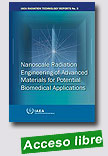 |
Nanoscale Radiation Engineering of Advanced Materials for Potential Biomedical Applications
IAEA Radiation Technology Reports, 2015, 214 p.
There are critical needs for advanced materials in the area of biomaterial engineering, primarily in generating biomaterials of enhanced specific functionalities, improved biocompatibility and minimal natural rejection and with enhanced interfacial adhesion. These can be achieved by the introduction of proper functionalities at the nanoscale dimension. Radiation techniques are uniquely suited for such a task due to their
|
|
 |
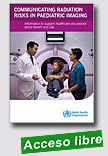 |
Communicating radiation risks in paediatric imaging - Information to support healthcare discussions about benefit and risk
World Health Organization (WHO), 2016, 94 p.
Patients and families need to have access to risk-benefit discussions about health care interventions when, where, and in the way they need to best understand and use the information. This dialogue with patients and families is particular relevant in the field of paediatric imaging. Accurate and effective radiation risk communication is also necessary between health care providers who request or perform
|
radiological medical procedures in children. By enabling informed decision-making, effective radiation risk communication contributes to ensure the greatest possible benefit , at the lowest possible risk. The document “Communicating radiation risks in paediatric imaging- Information to support health care discussions about benefit and risk” is intended to serve as a tool for health care providers to communicate known or potential radiation risks associated with paediatric imaging procedures, to support risk-benefit dialogue in health care settings.
Executive Summary English | Resumo - Português | Report
Extraído de: http://www.who.int/ionizing_radiation/pub_meet/radiation-risks-paediatric-imaging/en/
|
| |
| |
|
|
| |
|
